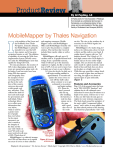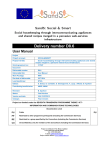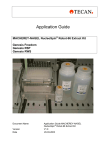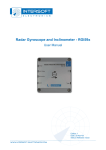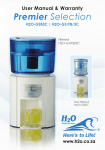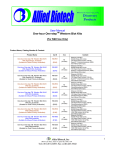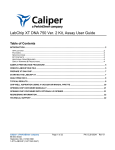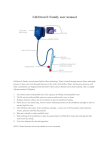Download Prototype User`s Manual and Safety Concerns
Transcript
Step-by-Step Instructions for Operation of Human Powered Water Still 1) Charge still with 2.7 liters of unpurified water by pouring into graduated cylinder. The water level within the cylinder should read 500 mL. 2) Mount the bicycle in standard fashion, facing forward with both feet on the pedals and hands gripping the handlebars. 3) Adjust the remote valve control dial to position 4, and allow 100 mL of water to drain from condenser reservoir to boiler (down to 400 mL level on the graduated cylinder). 4) Close valve by returning remote valve dial to position 0, fully closed for the valve. 5) Begin pedaling at a steady, sustainable rate. 6) Read values of current, voltage, temperature, and rpm from LCD screen, using push-button to toggle between each output. 7) Watch for condensation of purified water into collection vessel. 8) Upon first drips of water into collection vessel, open valve as indicated in step 3, and allow 25 mL of water to flow from condenser reservoir into boiler container. This will replace the water that has been boiled away. 9) For every 25 mL of purified water subsequently collected, use remote valve control to feed back an additional 25 mL of unpurified water into boiler. 10) Upon collection of satisfactory amount of purified water, stop pedaling. 11) Wait until all components are cool before attempting to handle any parts of the system. 12) Drain any remaining water in the graduated cylinder into boiler container by opening the valve as in step 3. 13) Empty any remaining water in the condenser reservoir by carefully disconnecting both PVC tube from elbow and vinyl tubing from copper nozzle. Turn condenser assembly upside down and empty water into proper container, draining liquid out of the top of the graduated cylinder. This water is not purified, and should not be consumed. 14) Remove any liquid remaining in boiler by undoing tension strap from hooks, lift off lid assembly, remove boiler container, and pour liquid into proper container. This water is also not purified, and should not be consumed. 15) Clean out contaminate residue left in boiler before re-assembly. 16) Return all components to original positions. Place boiler underneath lid and use tension strap to hold lid down. Reconnect PVC and vinyl tubing to condenser lid. 17) Enjoy pure water. USER’S MANUAL UNDERSTANDING THE HUMAN POWERED WATER STILL A. System Function Overview The Home Brew Water Crew human-powered still uses human power to boil unclean water to a water vapor which is then recollected in a separate chamber as clean water. The system has three main functions: power generation from pedaling, heating of water, and collection of condensed water vapor. Energy in the system is converted from Mechanical (pedaling motion) to Electrical (generator electricity output) to Thermal (heating element output). Important system performance data is measured with sensors that relay data to a microcontroller; this microcontroller displays measured values (current, voltage, rotational velocity, power, and temperature) on a LCD screen. Connections among functional components are integral to system operation. Primary connections include the sprocket-and-chain system linking the pedal cranks to the generator shaft, electrical connections between generator and heating element, and plumbing connections between heating chamber, condensing coils, and condensing chamber. This system also includes valve-controlled feedback from water in the condensing chamber to the heating chamber. The condensing chamber water absorbs heat from steam in condensing coils, and can be incrementally added back to the heating chamber to be vaporized after already experiencing thermal gain. B. System User Operation User operation for the Home Brew Water Crew still system consists of four main tasks: preparing the system, power generation, system monitoring, and feedback valve control. 1. Preparing the System Assembly Before operation, the user must verify that the system is completely assembled and all bolted connections are secure. The bike frame and generator with shaft connections must be secured to the wooden base. The boiler/condenser assembly should be connected to the generator via electrical wires, with no exposed metal wires. The top of the boiler must be firmly strapped down to the wooden base, and all connections of white PVC piping and clear plastic tubing must be tightly secured. Charging the Still The operation of the system begins with the user charging the still with unpurified water by pouring it into the graduated cylinder above the condenser assembly. The water will completely fill the condenser reservoir (2.2 liters) and also fill the graduated cylinder to the 500 mL line. This cylinder will be used to accurately display exactly how much water is incrementally fed into the boiler container. The initial water is fed into the boiler through a remotely operated ball valve. The valve is opened by the user via the standard gear shifter dial on the handle bar of the bicycle, with first gear and fourth gear corresponding to fully closed and open, respectively. The initial volume of water to be placed in the boiler is 100 mL. 2. Power Generation The user begins the distillation process by mounting the bicycle in standard fashion, facing forward with both feet on the pedals and hands gripping the handlebars for stability. The user will begin pedaling the bicycle in the forward direction at an estimated speed of 2 revolutions per second (120 rpm). Power generation is the fundamental operation task. For best system performance, the user should be generating 140+ Watts of energy and rotating the pedals at 2 revolutions per second; this translates to the type of exertion that would tire an in-shape person in 10-15 minutes. To improve system performance, the user should maintain a consistent pedaling rate and avoid sudden stops or reversing the pedal direction. Lateral motion or torquing the bike frame would be a waste of energy and stress the support frame in a direction of unintended force. The pedaling will transfer rotation via a chain to a sprocket hub, consisting of various sized sprockets, in the rear of the bicycle. This hub is fixed to the rear wheel, causing all rear sprockets and the wheel to rotate at a uniform angular velocity. A secondary chain is attached from the largest sprocket on the hub to a sprocket mounted onto the generator shaft. Thus, the rotational pedaling motion from the user is transferred through a dual-stage gear reduction sequence with chains and sprockets, and is used to rotate the input shaft of a generator to produce power. 3. Vaporization The voltage and current produced within the generator will be directed through wires into a nickel-chromium alloy heating element that is placed within the boiling container. The boiler container is a vacuum-insulated stainless steel cylinder that will be used to hold the unpurified water prior to boiling. As the user pedals and more power is generated, the heating element temperature will increase and effectively boil the water in the container. As the water reaches boiling temperature and absorbs enough energy for vaporization, it will undergo a phase change from liquid to vapor. The steam will then travel up a plastic PVC tube that is attached to the boiler lid. This PVC tube is the pathway for the steam to travel from the boiler to condenser. 4. Condensation Within the condenser, the steam will travel through a copper coil that is immersed in water, which provides a more efficient water cooled condensation. The water will absorb the latent heat of condensation and increase in temperature. This now “heated” water will then be recycled and fed incrementally back into the boiler container, thus effectively “preheating” it and conserving energy that would have otherwise been lost to the environment. This improves the efficiency of the process. The pure, condensed water will flow through the copper coil and be gravity-fed into a collection container below the condenser. 5. System Monitoring The embedded intelligence in the system will constantly update and display values of the water temperature within the boiler. Values of current, voltage, and power generated will also be read and displayed, as well as the rpm of the generator. The user will read these values from an LCD screen mounted in sight, and will be able to toggle between value displays through a push-button interface. The user must have a basic understanding of the expected system performance to properly monitor it on the LCD screen. Two of the direct signs of performance are rotational velocity, which should be above 600 rpm, and voltage, which should be 20 V or more. Temperature in the boiler should rise above 80° Celsius in approximately 15 minutes of system usage; low temperatures or slow response would indicate breakage or failure of the heating element—this is a situation where operation should be stopped. 6. Feedback Valve Control The feedback valve is used to add polluted water to the heating chamber from the condenser chamber. At the first notice of water dripping from the condenser coil into the collection vessel, the user should then use the remote valve control to feed an additional 25 mL of water into the boiler. After each subsequent collection of 25 mL pure water, the user will then use the remote ball valve control to refill the boiler 25 mL. The water is gravity-fed through a plastic hose when the valve is opened. The exact amount of water that is fed can be determined by reading the volume from the markings on the graduated cylinder. The group estimates that 25 mL is contained in intermediate stages within the system (after vaporization, but before final exit into collection vessel). This is why the user begins feedback at the first sign that water is dripping. This will ensure that there is always an acceptable liquid level within the boiler to prevent the heating element from burn-out. The valve is opened by using the bicycle shifter; four “clicks” upward will sufficiently open the valve, and shifting back to the original position returns the valve to fully-closed. C. Safety Concerns In regular operation, there are no major hazards for the operator of the Home Brew Water Crew still. The bicycle supports are designed to support loads in regular usage; vigorous use and lateral forces may weaken the structure over time. Electrical components operate in a range below shock hazard, are generally kept away from the operator, and are well insulated. The heating chamber and pipes to the condensing chamber will reach high temperatures, and the user is advised to allow time for these parts to cool after operation before touching them. A broken heating element or temperature sensor holding tube may contain broken glass and should be handled with extreme care.




